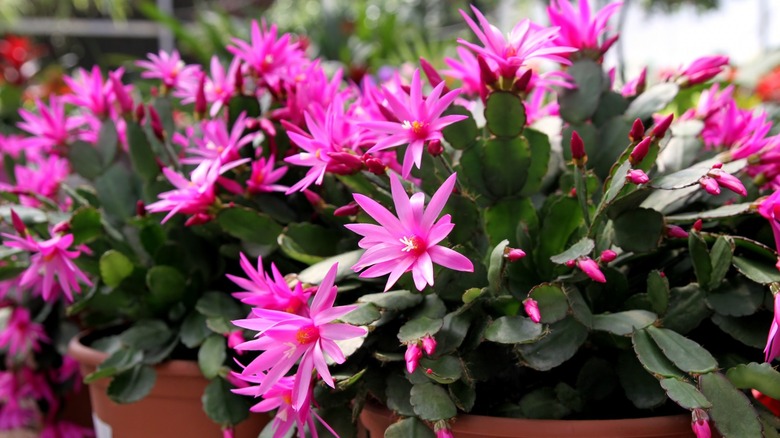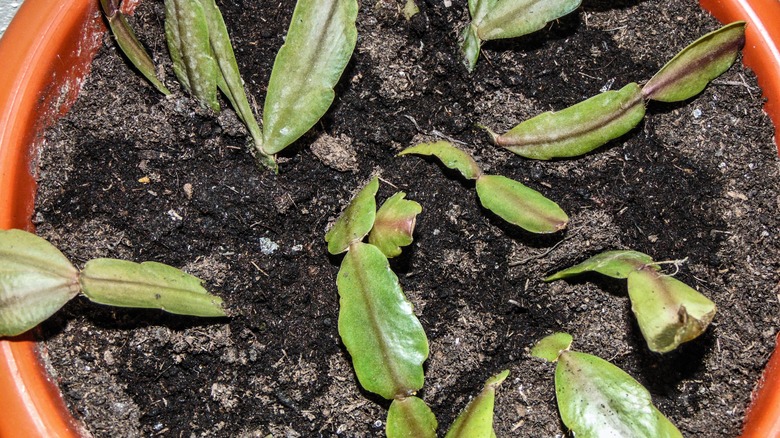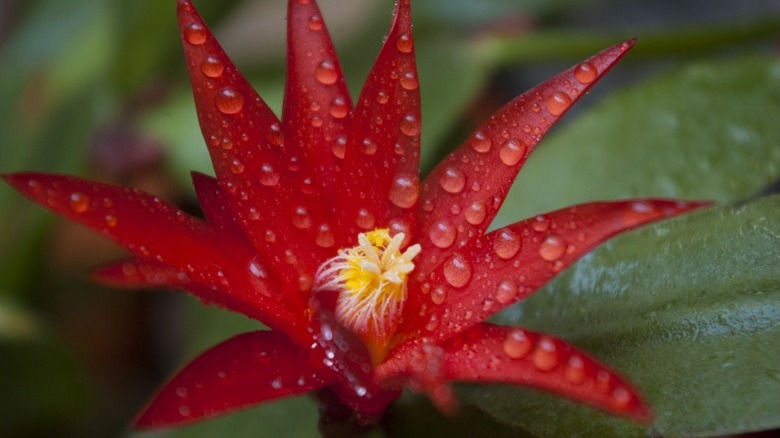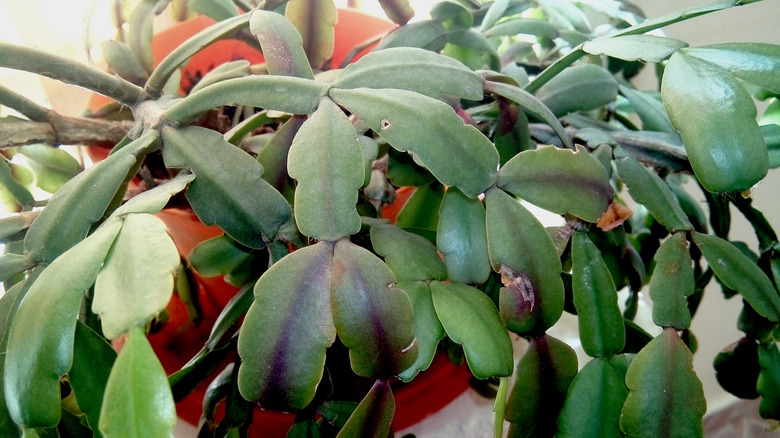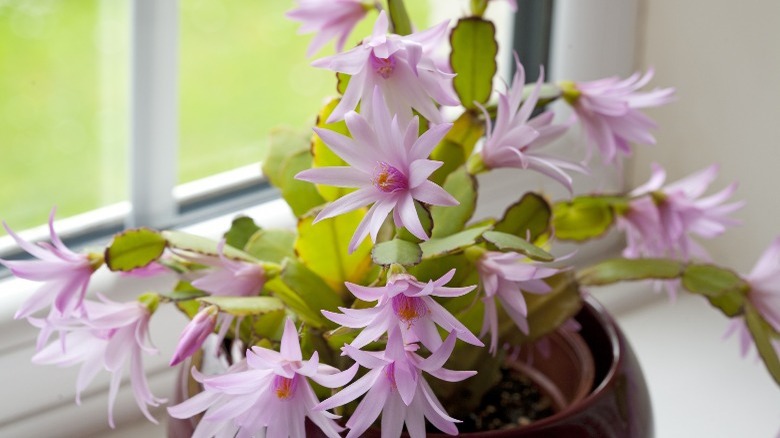How To Grow And Care For A Spring Cactus
The spring cactus, also referred to as the Easter cactus, is a simple yet elegant addition to your indoor houseplant collection. This beautiful epiphytic cacti hails from the rainforests of Brazil and is one of the three plant species that are collectively called Holiday Cacti, named for the time in which they bloom. While Rhipsalideae gaertneri belongs to the cactus family, it is quite different from its semi-arid counterpart. A spring cactus requires more care and attention than the better-known desert species of cacti. The Spruce confirms that they thrive in cold climates and can equally withstand direct sunlight.
A spring cactus is quite a delight to the eyes when in bloom. Different varieties produce different colors, but they range from pastels like peach, white, and lavender to bolder shades of red and pink. The stems grow in flat segments with scalloped edges, giving the plant a uniquely exotic appearance. If you are new to indoor gardening and are trying to decide which potted plants to get, you should definitely consider a spring cactus. According to SF Gate, a spring cactus is not only a hardy plant, but also requires minimal work, making it ideal for both beginner gardeners and seasoned florists.
How to grow a spring cactus
Right from the jump, it is important to realize that this is not your regular cactus plant. According to The House Plants Experts, this epiphytic cacti variety does not grow in the soil, but instead roots in rocky crevices or tree canopies in its natural habitat. Trying to grow this plant in compact soil will not yield the best results in the long run. Be sure to provide loose, well-aerated potting mix with perlite, for example, and organic matter to enhance growth and allow for proper airflow.
When it comes to propagation, the spring cactus behaves similarly to other succulent species. It is best to schedule the propagation during late spring or early summer when the plant is done blooming. To propagate by leaf cuttings, all you have to do is to carefully cut off a part of the stem, about two or three segments long. You can plant a day or two later after the cut section has completely dried out. Sink the lower segment into pre-prepared soil aggregate. Keep the aggregate slightly moist to encourage growth, but prevent rotting.
How to care for a spring cactus
If you're considering growing a spring cactus as a houseplant, proper care practices are paramount. In their natural habitat, spring cacti exist in the undergrowth of the Brazilian rainforest, shaded from the scorching sun by much taller trees. Gardening Know-How confirms that they prefer much cooler temperatures, about 55 to 60 degrees Fahrenheit, and will bloom for longer under these conditions compared with warmer environments.
Watering practices also play a significant role in the health of this particular cactus variety. As with most plants, you should water your spring cactus more frequently after planting to encourage growth. However, make sure you allow the soil or potting mix to dry out before repotting the plants. Remember, a spring cactus doesn't handle excessive water too well, and you should only plant them in pots with enough drainage. Though it hails from the rainforest, a spring cactus requires a period of dryness to initiate its blooming season. Gardening Know-How recommends tapering off watering and reducing the plant's exposure to sunlight in the two or three months prior to its expected flowering.
The application of fertilizers is also key. Spring cacti are known to be heavy feeders, requiring monthly fertilization according to The Spruce. However, the frequency will depend somewhat on other factors, such as how often you change or amend the soil. Additionally, you will need to taper off fertilization in the months leading up to the expected bloom season, as you do with watering.
Spring cactus varieties
As mentioned earlier, the spring cactus is named for the time in which it blooms, which is typically between March and May. Easter cacti are most commonly grown indoors as houseplants, and according to LLIFLE they have a long life expectancy, so you should plan to care for and maintain your plant well into the future. The spring cactus is available in a few different varieties, each with its own distinct physical appearance and different colorful flowers so you can easily tell them apart. Logee's provides more details for each variety:
- 'Colomba' spring cactus (Rhipsalidopsis gaertneri): Also known as the orange Easter cactus, which refers to this variety's lustrous, star-shaped orange flowers that bloom from March to May.
- 'Sirius' spring cactus (Rhipsalidopsis hybrid): Commonly referred to as the white Easter cactus, this all-white variety perhaps best embodies the sense of hope and renewal that is associated with the holiday. It blossoms around April through June and is often used to brighten windows in early spring.
- 'Scorpius' spring cactus (Rhipsalidopsis gaertneri): This variety is best-known for its dazzling bright red flowers that bloom from March until May. Like the other varieties, its light-sensitive flowers open at sunrise and close as the sun sets.
Is a spring cactus toxic?
If you are looking to increase the aesthetic appeal inside your house, what better way to do so than by adding some houseplants? Adding some greenery can bring joy to your space, and help you kickstart a new hobby. As with any changes to your living space, it is important to know certain details before introducing a new plant to your home, and plant toxicity is a valid concern, especially for homeowners with pets or small children.
Luckily, there's no need to worry if you are hoping to grow a spring cactus. According to OurHousePlants.com, no part of the spring cactus is toxic to humans or pets. Additionally, unlike their desert counterparts, spring cacti lack sharp thorns or spikes, making them a safe choice in even the more accessible parts of your home. Though it is not edible, a spring cactus can still enhance your home with its physical beauty and subtle fragrance.
How to repot a spring cactus
A spring cactus should be repotted every two or three years in order to replenish the nutrients and minerals in the soil that have depleted over time. The Spruce explains that spring cacti prefer to be slightly root-bound, so it is not always necessary to change the size of their container when repotting. If you are using the same pot, the repotting process begins with washing it with a combination of warm water and soap, to kill any harmful bacteria or pathogens.
Once your container is clean, fill the bottom with 1/4 to 1/2 inch of gravel or small rocks, in order to improve drainage. You can use a cactus-specific potting mix, which should be available at your local nursery or garden center. You can also opt to prepare your own, as Garden Guides suggests, by mixing peat moss, sand, and soil in equal measure. Fill the container halfway, and center the plant inside the pot. Pour in the remainder of the aggregate around the plant, leaving 1-inch of space from the rim of the container. Press the soil down firmly and finish by watering your plant after repotting.
